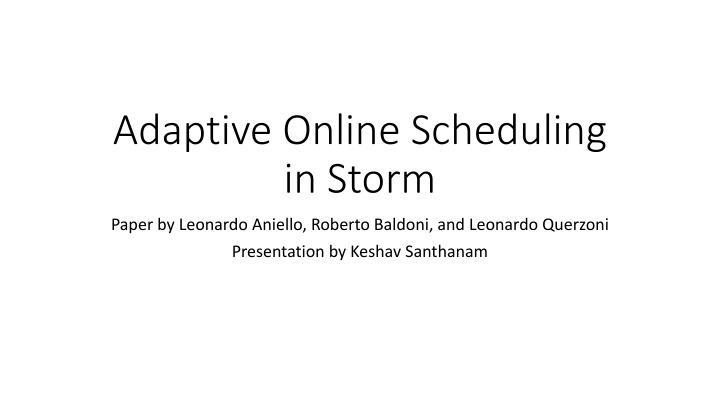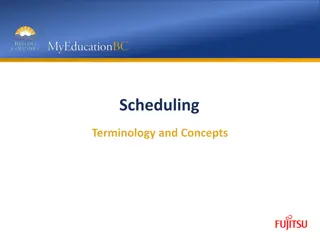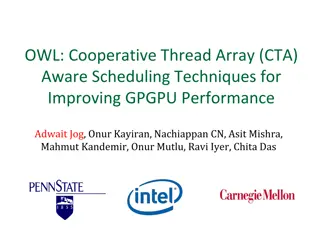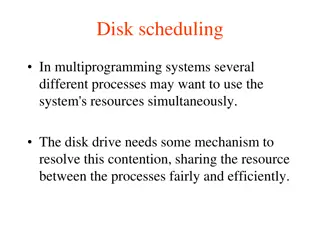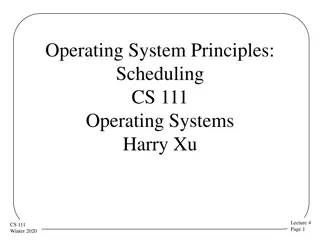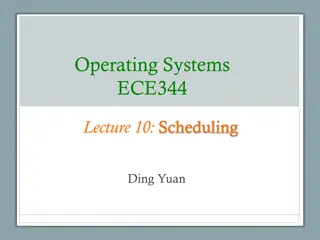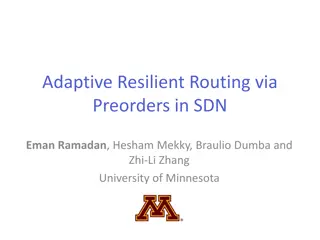Adaptive Online Scheduling in Storm
Leveraging adaptive scheduling techniques in the Storm framework to optimize network traffic by grouping communicating executors, this paper explores offline and online scheduling strategies for efficient data processing in high throughput streams. By using heuristics and runtime analysis, network communication overhead is minimized, benefiting systems dealing with large volumes of diverse data types.
Download Presentation

Please find below an Image/Link to download the presentation.
The content on the website is provided AS IS for your information and personal use only. It may not be sold, licensed, or shared on other websites without obtaining consent from the author.If you encounter any issues during the download, it is possible that the publisher has removed the file from their server.
You are allowed to download the files provided on this website for personal or commercial use, subject to the condition that they are used lawfully. All files are the property of their respective owners.
The content on the website is provided AS IS for your information and personal use only. It may not be sold, licensed, or shared on other websites without obtaining consent from the author.
E N D
Presentation Transcript
Adaptive Online Scheduling in Storm Paper by Leonardo Aniello, Roberto Baldoni, and Leonardo Querzoni Presentation by Keshav Santhanam
Motivation Big data 2.5 quintillion bytes of data generated per day [IBM] Volume, velocity, variety Need complex event processing engine Represent data as a real-time flow of events Analyze this data as quickly as possible
Storm Processing engine for high throughput data streams Used by Groupon, Yahoo, Flipboard, etc.
Storm Topology: Directed graph of spouts and bolts Tuple Tuple Bolt Bolt Data source Output Spout Bolt Tuple Tuple Bolt Bolt
Storm Worker Process Executor Supervisor Topology G(V, T), w Scheduler Plugin S Slots Deployment Plan Worker nodes Nimbus
Storm Grouping strategies Shuffle grouping: target task is chosen randomly Ensures even distribution of tuples Fields grouping: tuple is forwarded to a task based on the content of the tuple E.g. tuples with key beginning with A-I are sent to one task, J-R to another task, etc.
Storm EvenScheduler Round robin allocation strategy First phase: assigns executors to workers evenly Second phase: assigns workers to worker nodes evenly Problem: does not take into account network communication overhead Solution: Identify hot edges of the topology Map hot edges to inter-process channels
Adaptive Schedulers Key idea: place executors that frequently communicate together into the same slot, thus reducing network traffic Offline scheduler Examine the topology before deployment and use a heuristic to place the executors Online scheduler Analyze network traffic at runtime and periodically re-compute a new schedule Assumptions Only acyclic topologies Upper bound on number of hops for a tuple as it traverses topology Parameter [0, 1] affects the maximum number of executors in a single slot
Offline Scheduler 1. Create a partial ordering of components If component ci emits tuples that are consumed by another component cj then ci < cj If ci < cj and cj < ck, then ci < ck (transitivity) There can be components ci and cj such that neither ci < cj nor cj < ci are true 2. Use the partial order to create a linearization If ci < ci then ci appears before cj in The first element of is a spout 3. Iterate over and for each component ci, place its executors in the slots that already contain executors of the components that directly emit tuples towards ci 4. Assign the slots to worker nodes in round-robin fashion
Offline Scheduler Problem: If a worker does not have an executor it gets ignored Solution: Use a tuning parameter [0, 1] to force scheduler to use its empty slots Use a higher if traffic is expected to be heavier among upstream components
Offline Scheduler C1 < C3 C3 < C4 < C6 C2 < C5 < C6 C1 < C2 < C3 < C4 < C5 < C6 Bolt C3 Data source Spout Worker node 1 Worker node 2 C1 Worker process 1 Bolt C4 Worker process 3 Bolt Worker process 2 C6 Spout Bolt C2 C5
Offline Scheduler C1 < C2 < C3 < C4 < C5 < C6 Bolt C3 Data source Spout Worker node 1 Worker node 2 C1 Worker process 1 Bolt C1 C4 Worker process 3 Bolt Worker process 2 C6 Spout Bolt C2 C5
Offline Scheduler C1 < C2 < C3 < C4 < C5 < C6 Bolt C3 Data source Spout Worker node 1 Worker node 2 C1 Worker process 1 Bolt C1 C4 Worker process 3 C2 Bolt Worker process 2 C6 Spout Bolt C2 C5
Offline Scheduler C1 < C2 < C3 < C4 < C5 < C6 Bolt C3 Data source Spout Worker node 1 Worker node 2 C1 Worker process 1 Bolt C3 C1 C4 Worker process 3 C2 Bolt Worker process 2 C6 Spout Bolt C2 C5
Offline Scheduler C1 < C2 < C3 < C4 < C5 < C6 Bolt C3 Data source Spout Worker node 1 Worker node 2 C1 Worker process 1 Bolt C3 C1 C4 Worker process 3 C2 Bolt Worker process 2 C6 C4 Spout Bolt C2 C5
Offline Scheduler C1 < C2 < C3 < C4 < C5 < C6 Bolt C3 Data source Spout Worker node 1 Worker node 2 C1 Worker process 1 Bolt C3 C1 C4 Worker process 3 C5 C2 Bolt Worker process 2 C6 C4 Spout Bolt C2 C5
Offline Scheduler C1 < C2 < C3 < C4 < C5 < C6 Bolt C3 Data source Spout Worker node 1 Worker node 2 C1 Worker process 1 Bolt C3 C1 C4 Worker process 3 C5 C2 Bolt Worker process 2 C6 C4 C6 Spout Bolt C2 C5
Offline Scheduler C1 < C2 < C3 < C4 < C5 < C6 Bolt C3 Data source Spout Worker node 1 Worker node 2 C1 Worker process 1 Bolt C3 C1 C4 Worker process 3 C5 C2 Bolt Worker process 2 C6 C4 C6 Spout Bolt C2 C5
Offline Scheduler C1 < C2 < C3 < C4 < C5 < C6 Bolt C3 Data source Spout Worker node 1 Worker node 2 C1 Worker process 1 Bolt C3 C1 C4 Worker process 3 C5 C2 Bolt Worker process 2 C6 C4 C6 Spout Bolt C2 C5
Offline Scheduler C1 < C2 < C3 < C4 < C5 < C6 Bolt C3 Data source Spout Worker node 1 Worker node 2 C1 Worker process 1 Bolt C3 C1 C4 Worker process 3 C5 C2 Bolt Worker process 2 C6 C4 C6 Spout Bolt C2 C5
Offline Scheduler C1 < C2 < C3 < C4 < C5 < C6 Bolt C3 Data source Spout Worker node 1 Worker node 2 C1 Worker process 1 Bolt C3 C1 C4 Worker process 3 C5 C2 Bolt Worker process 2 C6 C4 C6 Spout Bolt C2 C5
Offline Scheduler C1 < C2 < C3 < C4 < C5 < C6 Bolt C3 Data source Spout Worker node 1 Worker node 2 C1 Worker process 1 Bolt C3 C1 C4 Worker process 3 C5 C2 Bolt Worker process 2 C6 C4 C6 Spout Bolt C2 C5
Online Scheduler Goal: dynamically adapt scheduler as load on nodes changes Need to satisfy constraints on: 1. Number of workers for each topology 2. Number of slots available on each worker node 3. Computational power on each node
Storm Architecture with Online Scheduler Worker Process Executor Supervisor Topology G(V, T), w Scheduler Plugin Plugin Scheduler Performance Log S Slots Deployment Plan Worker nodes Nimbus
Online Scheduler I. Partition the executors among the workers 1. Iterate over all pairs of communicating executors (most traffic first) 2. If neither executor has been assigned, assign both to least loaded worker 3. Otherwise determine the best assignment using executors current workers and least loaded worker II. Allocate workers to available slots 1. Iterate over all pairs of communicating workers (most traffic first) 2. If neither worker has been assigned, assign both to least loaded node 3. Otherwise determine the best assignment using workers current nodes and least loaded nodes
Online Scheduler [(C5, C6), (C4, C6), (C1, C4), (C2, C5), (C1, C3)] Bolt C3 Data source Spout C1 Worker process 1 Worker process 3 Bolt C3 C5 C1 C2 C4 Bolt Worker process 4 Worker process 2 C6 C4 C6 Spout Bolt C2 C5 Phase I
Online Scheduler [(C5, C6), (C4, C6), (C1, C4), (C2, C5), (C1, C3)] (Least loaded worker) Worker process 2 Worker process 3 Worker process 4 C5 C4 C2 C6 Bolt C3 Data source Spout C1 Worker process 1 Worker process 3 Bolt C3 C5 C1 C2 C4 Bolt Worker process 4 Worker process 2 C6 C4 C6 Spout Bolt C2 C5 Phase I
Online Scheduler [(C5, C6), (C4, C6), (C1, C4), (C2, C5), (C1, C3)] (Least loaded worker) Worker process 2 Worker process 3 Worker process 4 C4 C2 C6 C5 Bolt C3 Data source Spout C1 Worker process 1 Worker process 3 Bolt C3 C1 C2 C4 Bolt Worker process 4 Worker process 2 C6 C6 C5 C4 Spout Bolt C2 C5 Phase I
Online Scheduler [(C5, C6), (C4, C6), (C1, C4), (C2, C5), (C1, C3)] (Least loaded worker) Worker process 2 Worker process 4 Worker process 3 C6 C4 C5 C2 Bolt C3 Data source Spout C1 Worker process 1 Worker process 3 Bolt C3 C1 C2 C4 Bolt Worker process 4 Worker process 2 C6 C6 C5 C4 Spout Bolt C2 C5 Phase I
Online Scheduler [(C5, C6), (C4, C6), (C1, C4), (C2, C5), (C1, C3)] (Least loaded worker) Worker process 1 Worker process 2 Worker process 3 C1 C4 C3 C2 Bolt C3 Data source Spout C1 Worker process 1 Worker process 3 Bolt C3 C1 C2 C4 Bolt Worker process 4 Worker process 2 C6 C6 C5 C4 Spout Bolt C2 C5 Phase I
Online Scheduler [(C5, C6), (C4, C6), (C1, C4), (C2, C5), (C1, C3)] (Least loaded worker) Worker process 1 Worker process 2 Worker process 3 C1 C4 C3 C2 Bolt C3 Data source Spout C1 Worker process 1 Worker process 3 Bolt C3 C2 C4 Bolt Worker process 4 Worker process 2 C6 C6 C5 C4 C1 Spout Bolt C2 C5 Phase I
Online Scheduler [(C5, C6), (C4, C6), (C1, C4), (C2, C5), (C1, C3)] (Least loaded worker) Worker process 4 Worker process 3 C6 C2 C5 Bolt C3 Data source Spout C1 Worker process 1 Worker process 3 Bolt C3 C2 C4 Bolt Worker process 4 Worker process 2 C6 C6 C5 C4 C1 Spout Bolt C2 C5 Phase I
Online Scheduler [(C5, C6), (C4, C6), (C1, C4), (C2, C5), (C1, C3)] (Least loaded worker) Worker process 2 Worker process 1 C1 C3 C4 Bolt C3 Data source Spout C1 Worker process 1 Worker process 3 Bolt C3 C2 C4 Bolt Worker process 4 Worker process 2 C6 C6 C5 C4 C1 Spout Bolt C2 C5 Phase I
Online Scheduler [(C5, C6), (C4, C6), (C1, C4), (C2, C5), (C1, C3)] Bolt C3 Data source Spout Worker node 1 Worker node 2 C1 Worker process 4 Worker process 3 Bolt C6 C5 C2 C4 Bolt Worker process 1 Worker process 2 C6 C3 C4 C1 Spout Bolt C2 C5 Phase II
Evaluation Topologies General-case reference topology DEBS 2013* Grand Challenge dataset Key metrics Average latency for event to traverse the entire topology Average inter-node traffic at runtime Cluster specifications 8 worker nodes, each with: 5 worker slots Ubuntu 12.04 2x2.8 GHz CPUs 3 GB RAM 15 GB disk storage *The 7th ACM International Conference on Distributed Event-Based Systems
Evaluation Reference Topology <shuffle> <fields> <shuffle> <fields> <shuffle> stateful ack spout simple stateful stage N-1 stage 1 stage 2 stage N Each spout executor emits tuples at a fixed rate and the average of these rates is exactly R Bolts forward the received value the time and a different constant value the rest of the time
Evaluation Reference topology settings: 7 stages, replication factor of 4 for spout, 3 for simple bolts, 2 for stateful bolts Each point represents average latencies for a 10 events window
Evaluation Parameters: = 0, = 0.5, average data rate R = 100 tuples/s, variance V = 20%
Evaluation Parameters: = 0, = 0.5, average data rate R = 100 tuples/s, variance V = 20%
Evaluation Parameters: 5 stage topology, replication factor 5, R = 1000 tuples/s, variance V = 20%
Evaluation 2013 DEBS Grand Challenge sensors in soccer players shoes emit position and speed data at 200 Hz frequency goal is to maintain up-to-date statistics such as average speed, walked distance, etc. Grand Challenge Topology spout for the sensors (sensor) bolt that computes instantaneous speed and receives tuples by shuffle grouping (speed) bolt that maintains and updates statistics as tuples are received from the speed bolt (analysis)
Evaluation Spout Bolt Spout Bolt Bolt Spout Bolt Bolt Spout Bolt sensor (x8) speed (x4) <shuffle> analysis (x2) <fields>
